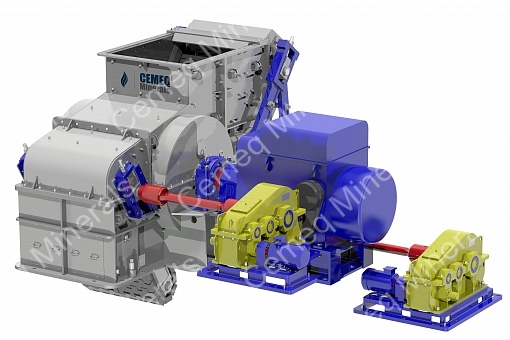 |
Hammer-type crushers
Hammer-type crushers are intended for crushing fragile and soft materials: black coal, rock salt, chalk, gypsum, crushed brick, alum, saltpeter alum, borax and limestone, some ores and other low abrasive materials. Simplicity of construction ensures reliable operation.
Part number:
Supplier:
CEMEQ Minerals LLCDescription
Hammer-type crushers are intended for crushing fragile and soft materials: black coal, rock salt, chalk, gypsum, crushed brick, alum, saltpeter alum, borax and limestone, some ores and other low abrasive materials. Simplicity of construction ensures reliable operation.
Currently, hammer-type crushers are widely used in various industries of building materials. In cement industry hammer-type crushers are used for preliminary crushing of clay, limestone, marl and chalk – the main components of cement. Hammer-type crushers are used for fine crushing of gypsum and other additives to the cement clinker. Grate coolers are equipped with hammer-type crushers for crushing the sintered pieces of cement clinker. In asbestos industry wide-spread hammer-type crushers are used effectively for crushing asbestos ore. Crushers make this operation for 3-4 steps.
Hammer-type crushers are used in production of finely divided carbonate materials, which are applied in manufacture of glass, filler in plastics, and also in production of dolomite and limestone meal. In manufacture of building brick, hammer-type crushers are used in crushing of bricks, coal, and dry clay.
In silica brick production hammer-type crushers are installed instead of ball mills for fine crushing of lime after its burning in shaft kilns.
In gypsum manufacture hammer-type crushers are used for primary and fine crushing of gypsum stone. In addition, such crushers are used in processing of mica and mica scrap, mining and processing of rock salt, phosphates, saltpeter and soda.
In coal industry they are used in crushing of coal accrete with gangue. In heat-and-power engineering hammer-type crushers are used in fine grinding of coal used as fuel.
Crushers for crushing of materials that are prone to adhering are equipped with special devices in the form of cleaning canvas and rotating rolls. Source material is fed to the crushing canvas and transported to the rotor, where it is destroyed and thrown on the second cleaning canvas. After it, the finished product falls freely, and the adhered particles are removed by a scraper. The similar function is performed by the rolls. Design of the crusher is constructed to eliminate the crushed material contact with its stationary parts.
The variety of technological problems to be solved with the help of hammer-type crushers and the characteristics of production caused different solutions of this equipment.
Currently, hammer-type crushers are widely used in various industries of building materials. In cement industry hammer-type crushers are used for preliminary crushing of clay, limestone, marl and chalk – the main components of cement. Hammer-type crushers are used for fine crushing of gypsum and other additives to the cement clinker. Grate coolers are equipped with hammer-type crushers for crushing the sintered pieces of cement clinker. In asbestos industry wide-spread hammer-type crushers are used effectively for crushing asbestos ore. Crushers make this operation for 3-4 steps.
Hammer-type crushers are used in production of finely divided carbonate materials, which are applied in manufacture of glass, filler in plastics, and also in production of dolomite and limestone meal. In manufacture of building brick, hammer-type crushers are used in crushing of bricks, coal, and dry clay.
In silica brick production hammer-type crushers are installed instead of ball mills for fine crushing of lime after its burning in shaft kilns.
In gypsum manufacture hammer-type crushers are used for primary and fine crushing of gypsum stone. In addition, such crushers are used in processing of mica and mica scrap, mining and processing of rock salt, phosphates, saltpeter and soda.
In coal industry they are used in crushing of coal accrete with gangue. In heat-and-power engineering hammer-type crushers are used in fine grinding of coal used as fuel.
Crushers for crushing of materials that are prone to adhering are equipped with special devices in the form of cleaning canvas and rotating rolls. Source material is fed to the crushing canvas and transported to the rotor, where it is destroyed and thrown on the second cleaning canvas. After it, the finished product falls freely, and the adhered particles are removed by a scraper. The similar function is performed by the rolls. Design of the crusher is constructed to eliminate the crushed material contact with its stationary parts.
The variety of technological problems to be solved with the help of hammer-type crushers and the characteristics of production caused different solutions of this equipment.